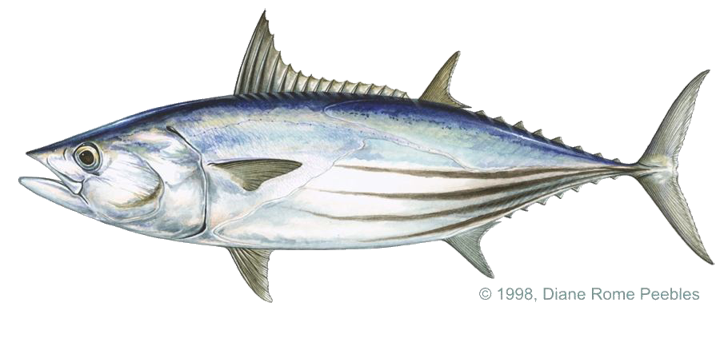Game Fish Identification Reference Guides
Tuna, skipjack
(Katsuwonus pelamis)
(Katsuwonus pelamis)

(Linnaeus, 1758); SCOMBRIDAE FAMILY; also called skipjack, ocean bonito, Arctic bonito, striped tuna, watermelon tuna
Cosmopolitan in tropical and subtropical seas, usually in deep coastal and oceanic waters. It is common throughout the tropical Atlantic, south to Argentina and may range as far north as Cape Cod, Massachusetts in the summer months. Skipjack tuna are schooling, pelagic, migratory, deep water species. In the western Atlantic, skipjack tuna frequently school with blackfin tuna (Thunnus atlanticus) and in the Pacific and Indian Oceans they often school with yellowfin tuna (Thunnus albacares). The common name Arctic bonito which is sometimes applied to the skipjack is a misnomer. The fish does not range into Arctic waters and is not a bonito, but a tuna.
The presence of stripes on the belly and the absence of markings on the back are sufficient to distinguish the skipjack tuna from all similar species. The lower flanks and belly are silvery with 4 to 6 prominent, dark longitudinal stripes running from just behind the corselet back towards the tail, ending when they come into contact with the lateral line. Though some other species do have stripes on the belly, they have markings on the back as well, and the latter remain the most prominent after death.
This is a gregarious fish and a fast swimmer. It feeds near the surface, forming schools composed of 50,000 or more individuals. It will strike trolled strip baits, feathers, spoons, plugs, or small whole baits. Some are taken by casting, jigging or live bait fishing off shore.
In addition to being an esteemed light tackle species, it has great commercial value. In the U.S. it is canned with yellowfin and bigeye tuna and sold as light meat tuna
Cosmopolitan in tropical and subtropical seas, usually in deep coastal and oceanic waters. It is common throughout the tropical Atlantic, south to Argentina and may range as far north as Cape Cod, Massachusetts in the summer months. Skipjack tuna are schooling, pelagic, migratory, deep water species. In the western Atlantic, skipjack tuna frequently school with blackfin tuna (Thunnus atlanticus) and in the Pacific and Indian Oceans they often school with yellowfin tuna (Thunnus albacares). The common name Arctic bonito which is sometimes applied to the skipjack is a misnomer. The fish does not range into Arctic waters and is not a bonito, but a tuna.
The presence of stripes on the belly and the absence of markings on the back are sufficient to distinguish the skipjack tuna from all similar species. The lower flanks and belly are silvery with 4 to 6 prominent, dark longitudinal stripes running from just behind the corselet back towards the tail, ending when they come into contact with the lateral line. Though some other species do have stripes on the belly, they have markings on the back as well, and the latter remain the most prominent after death.
This is a gregarious fish and a fast swimmer. It feeds near the surface, forming schools composed of 50,000 or more individuals. It will strike trolled strip baits, feathers, spoons, plugs, or small whole baits. Some are taken by casting, jigging or live bait fishing off shore.
In addition to being an esteemed light tackle species, it has great commercial value. In the U.S. it is canned with yellowfin and bigeye tuna and sold as light meat tuna












